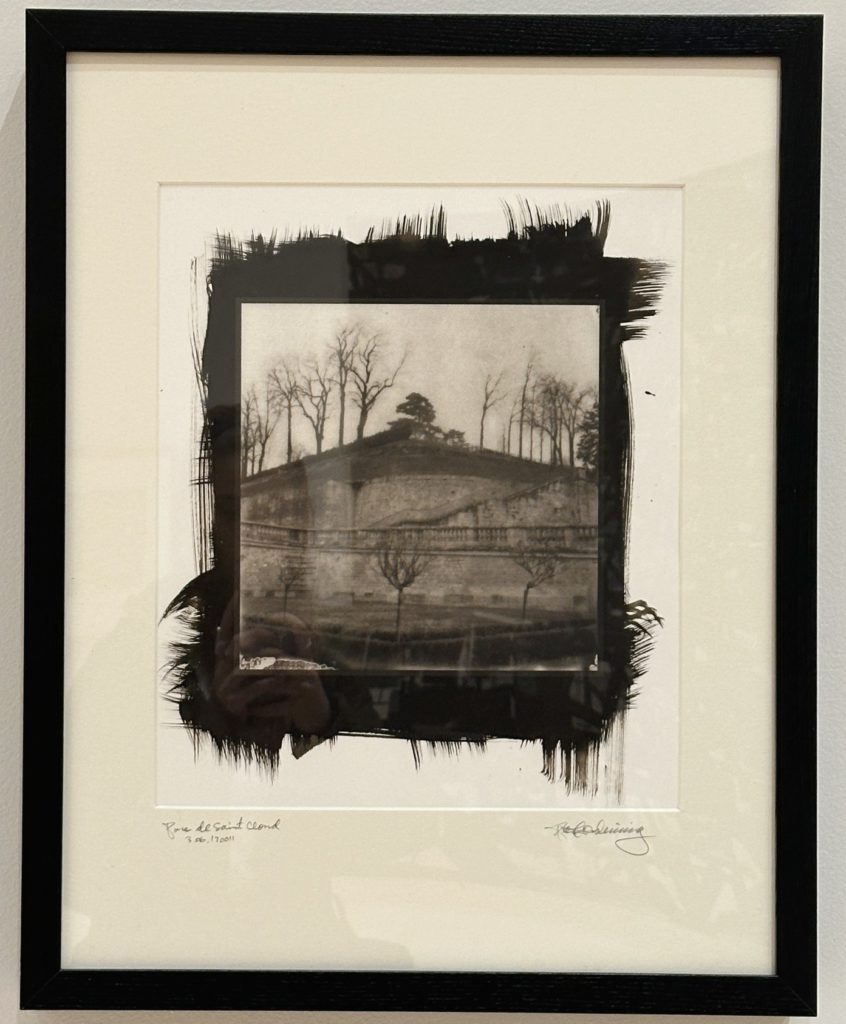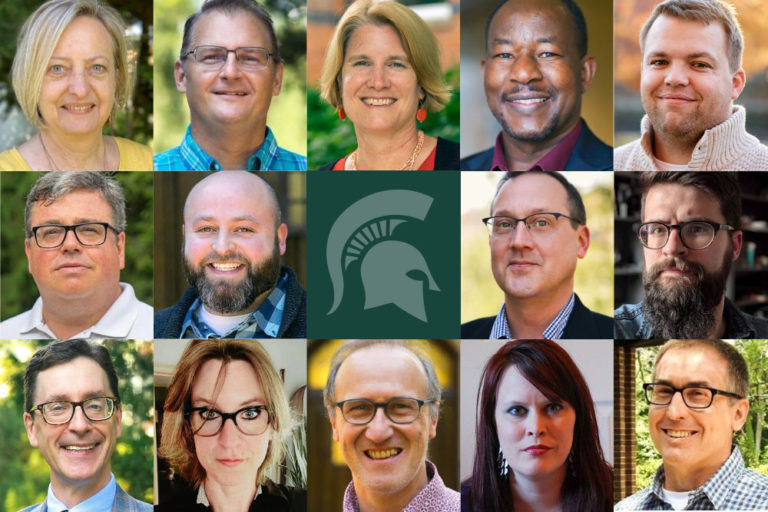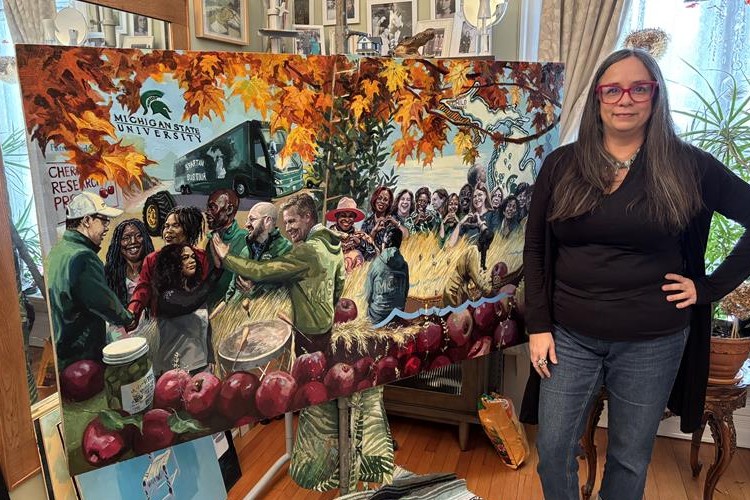The works of 22 Department of Art, Art History, and Design (AAHD) faculty are now on display through July 21, 2024, at the MSU Broad Art Museum as part of an exhibition that highlights the diverse, experimental, and interdisciplinary creative practices of these talented and internationally recognized artists/educators.
The 2024 Art, Art History, and Design Faculty Triennial exhibition offers a comprehensive sample of recent work that explores what it means to engage in imagination beyond the realm of fantasy. From an apron made of woven ceramic fingerbones to royal glitter portraiture, a radiochemical painting, and 19th-century photographic processing techniques, many different mediums and techniques were used through which faculty reimaged stories of life while examining the individual and communal histories, identities, and habits of human beings throughout time and cultures.

The triennial exhibition includes work by Thomas Berding, Rebekah Blesing, Adam Brown, Rebecca Casement, Candice Chovanec, Ryan Claytor, Laura Cloud, Lorelei d’Andriole, d’Ann de Simone, Benjamin Duke, Teresa Dunn, Xia Gao, Laurén Gerig, Peter Glendinning, Rebecca Gonzalez Cifaldi, Alisa Henriquez, Paul Kotula, Robert A. McCann, Nathan Prebonick, Kelly Salchow MacArthur, Rebecca Tegtmeyer, and Blake Williams.
The exhibition is supported by the John and Susan Berding Family Endowment and was guest curated by Asha Iman Veal, Associate Curator at the Museum of Contemporary Photography at Columbia College Chicago, along with Dalina A. Perdomo Álvarez, Assistant Curator at the MSU Broad Art Museum.
“The art world is not easy, nor is the solitude of creativity, but each time we believe that the human voice and heart matters, we act to repair a world in tatters. So, I thank my artist-colleagues, and I honor them because working among them is both a privilege and an honor.”
Tani Hartman, Chair of the Department of Art, Art History, and Design
“The core belief that drives me as an artist, educator, and now arts administrator is that the acts of scholarship, design, and art are acts that heal and repair a damaged world, acts that recover human wholeness and restore our capacity to empathize and to imagine,” said Tani Hartman, Chair of the Department of Art, Art History, and Design. “Whether the art is the caring and transformative acts of excavation and documentation by the artist and educator Paul Kotula, or the sweeping, emotional, and immersive suite of paintings by artist and educator Tom Berding, the contemplative embroideries with deeply impactful content by Rebecca Tegtmeyer, the intricate and awe-inspiring hoops of d’Ann de Simone, or the created, alternate worlds of each artist who was willing to vulnerably expose themselves to scrutiny; each artist acted from the committed, brave choice of believing that they will be heard. The art world is not easy, nor is the solitude of creativity, but each time we believe that the human voice and heart matters, we act to repair a world in tatters. So, I thank my artist-colleagues, and I honor them because working among them is both a privilege and an honor.”

An opening reception for the exhibition was held on Feb. 2 during the museum’s 2024 Winter Opening Party. This event also celebrated the launch of the new DOOMSCROLLING exhibition by Kayla Mattes, which will be on display at the museum through mid-August. Visitors who attended the Winter Opening Party had the opportunity to explore the exhibitions while enjoying food, music, special guests, artmaking activities, and more.
AAHD Faculty in the Exhibit:
The following are the faculty members who are part of the Art, Art History, and Design Faculty Triennial exhibition with a brief explanation of their work in the exhibition.
Thomas Berding
Thomas Berding, Professor of Painting, has a series of 15 paintings in the exhibition that are from the Everyday Elsewhere Series. Using paint and collage, Berding presents viewers with a haunting and speculative image of the world that draws on the history of abstract painting, digital and post-industrial refuse, and observations on contemporary life.

Rebekah Blesing
Rebekah Blesing, Assistant Professor who teaches Art Foundations courses, created a resin print of an adult dragonfly, titled Tympanum. Spending most of their existence as immature nymphs and only a few weeks as an adult, dragonflies’ imbalanced lifespan and limited existence have symbolic meaning across many cultures, which Blesing draws upon, using the dragonfly as an expression of grief, thinking of it as existing in a realm between life and death.
Adam Brown
Adam Brown, Professor of Electronic Art and Intermedia, working with Dr. Gregory Severin, remediated Vincent van Gogh’s famous Sunflowers paintings, utilizing biology, radiochemistry, and heavy metal contaminants to explore the intersection between science and art. Instead of hand-painted sunflowers, this work is composed of radiographic data taken from a sunflower that had absorbed metal contaminants to produce a visual trace of the data and a portrait of the flower.

Rebecca Casement
Rebecca Casement, Assistant Professor of Ceramics and Sculpture, presents a clay, steel, and resin sculpture, titled Sublime. The sculpture uses the vessel form as a symbol of the body in an imperfect state, looking to express emotions and experiences instead of using sculpture as a representation of a perfected human form. Imprinted in the art is how we use our bodies and our words to harm and heal. It asks the question of what our role and responsibility to society is as individuals and collectively.
Candice Chovanec
Candice Chovanec, Assistant Professor who teaches Art Foundations and Integrated Arts and Humanities courses, created a series of abstract paintings, titled Iterations, which are inspired by koans, a Zen Buddhist prompt used during meditation that consists of an unanswerable question or riddle, such as “How does the flower perceive the bee?”

Ryan Claytor
Ryan Claytor, Assistant Professor of Comics and Graphic Novels and Coordinator for the Comic Art and Graphic Novel minor, has a comic book that he produced in the exhibition. This comic book visually adapts a poem from his late grandfather, Charles Kermit Claytor. A Hunter’s Tale: A Comics Poem by My Grandfather centers around an unlikely encounter between a hunter and his prey that becomes a lesson in empathy.
Laura Cloud
Laura Cloud, Associate Professor of Sculpture, has a series of travel photos, titled Fragments of History: Turkey, in the exhibition. Through these photos, Cloud aims to present new viewpoints and fragments of architecture from the ancient world to remind us that the historical past is still relevant to our present.

Lorelei d’Andriole
Lorelei d’Andriole, Assistant Professor of Electronic Art and Intermedia, created a sculptural and audio-visual installation, titled Heel Toe Express, which consists of 10 pairs of shoes that function as instruments. Using sound and recorded performance to represent feelings d’Andriole experienced early in her transition around clothing inclusivity for trans women, the shoes and other salvaged objects in the installation produce unique sounds and functionally to tell their story to encourage audiences to move away from imagining themselves in someone else’s shoes and towards letting the shoes speak to them.
d’Ann de Simone
d’Ann de Simone, Professor of Painting and Printmaking, has two mixed-media works in the exhibition, titled omphalos and euthymia II. Inspired by her Italian upbringing, these works employ the Tondo style of circular painting, popular during the Italian Renaissance, while also incorporating materials and techniques that are often associated with “women’s work,” like textiles, needlework, and sequins. Many of the materials were collected by her late mother, others are acquired second hand. de Simone considers herself a collaborator with all these women, decontextualizing and building upon their initial labors to recontextualize and honor their legacies. In creating this work, de Simone advances the conversation regarding the hierarchical division embedded in the practice of craft and fine arts. She also seeks to dissolve the hierarchical division between craft and fine arts. Yet she believes that breaking of “the canon” to include those practices coded as “feminine, domestic, or vernacular” still remains elusive.

Benjamin Duke
Benjamin Duke, Associate Professor who teaches Art Foundations classes, created two oil paintings depicting stories of adventure, tragedy, and survival from the crew of the Essex, an American whaling ship that sunk in 1820, leaving the crew stranded at sea for several months. One of the paintings, The Sailor’s Wife, is a portrait of the wife of the first mate of the Essex. And In the Land of Nod. Episode 1: The Fearful Tale of the Essex, Duke paints himself as the captain of the ship and includes pop-culture and political figures as crew members.
Teresa Dunn
Teresa Dunn, Professor of Painting, created a large-scale oil painting, titled Long Line of Women, that visualizes the narratives of marginalized experiences, especially those of Black and Brown women. Dunn’s work often features people in her life whose experiences inspire her while drawing from her experience as a brown Mexican woman from the Midwest. Themes of isolation, belonging, joy, and hope emerge in her canvases. At the same time, she encourages viewers to linger in the tensions that arise when confronted with questions of race, identity, and gender.

Xia Gao
Xia Gao, Associate Professor of Apparel and Textile Design and Studio Arts, created a sculptural installation, titled Vanishing. Vertically hanging rope, thermochromic paint, and a programmed heat lamp combine in this piece to present the silhouette and story of an upside-down tree. As the thermochromic paint reacts with the heat lamp, the appearance of the tree changes in reference to the temperature data since 1850, demonstrating human impact on the earth.
Laurén Gerig
Laurén Gerig, Assistant Professor who teaches Art Foundations courses and serves as the Interim Outreach Coordinator, created an oil painting, titled Something it cannot name, depicting the shores of the Great Lakes. Her brushwork explores the emotional and psychological attachments created by daily interactions with landscapes and the sense of urgency experienced when trying to capture your natural surroundings.

Peter Glendinning
Peter Glendinning, W.J. Beal Distinguished Professor, presents a photographic print from the series Le Fantome d’Atget (translation The Ghost of Atget). The work originally was formed as a Polaroid SX-70 image, which was then scanned to create a full-sized negative for printing in the platinum/palladium process in his darkroom. The series is not a re-photographic survey of Jean Eugene Atget’s corpus. It is rather an attempt to work within the same tradition, toward the same goals as the master, in the same place, Paris. As John Szarkowski described Atget’s metier: “…he practiced photography not to express what he knew and felt, but to discover what he might know and feel.”

Rebecca Gonzalez Cifaldi
Rebecca Gonzelez Cifaldi, Assistant Professor of Graphic Design, contributed two works to the exhibition that combine handwriting and Gum bichromate photographic portraiture, which creates a painterly effect. The series serves as a visual accumulation of the days after a crisis, where the uncertain nature of grief and trauma still lingers.

Alisa Henriquez
Alisa Henriquez, Professor of Painting, presents a mixed-media piece, titled Her Regal Bearing, that combines popular culture and art history to create a contemporary, abstract portrait. Using paint, vinyl, fabric, and glitter, her work integrates figuration and abstraction in a kaleidoscopic and near dizzying fashion, suggesting we are in the midst of a cosmic, mysterious, and radiant presence.
Paul Kotula
Paul Kotula, Associate Professor of Ceramics, created an art installation piece, titled Harvest, which consists of fragments from our commodified world that the artist unearthed while gardening. He contrasts these scraps and objects with a tree root and a series of his handmade bowls to question industry’s impact on our environment while reanimating craft’s rejection of industrialization.
Robert A. McCann
Robert A. McCann, Associate Professor of Painting, has a painting, titled Death Star, in the exhibition that was created from oil paints on linen cloth. This maximalist work presents a seemingly ordinary domestic scene whose surrealist, epic, and uncanny elements reveal themselves to the viewer with time.

Nathan Prebonick
Nathan Prebonick, Assistant Professor of Drawing and Printmaking, presents two works, an acrylic painting, titled Palisade, and a lithograph with screen-printed additions, titled Rotary. With inspiration drawn from his experience as an urban explorer and avid fisherman, his painted works, like Palisade, are geometric and topographic to represent passageways. While his print works, like Rotary, are hazy and translucent, like residue accumulating over time.
Kelly Salchow MacArthur
Kelly Salchow MacArthur, Professor of Graphic Design, has two printed posters in the exhibition. Titled ONE planet and ONE choice, Salchow MacArthur combined analog and digital methods to create the posters, which serve as both a representation of her connection to the natural environment and as a call to action.
Rebecca Tegtmeyer
Rebecca Tegtmeyer, Associate Professor of Graphic Design, created two hand-embroidered data visualizations, titled Restricted Reproductive Rights and Workplace Decline During the Pandemic 2/20-1/21, that are part of the exhibition. The materials and techniques used in these works provide a feminist retelling and analysis of familiar statistics.

Blake Williams
Blake Williams, Associate Professor of Ceramics, created a mixed-media sculpture, titled Secret Recipes, which explores the senses as catalysts for memory with hundreds of porcelain thumb bones woven into an ossified apron. Digital decals of her mother’s handwritten recipes were fused to the back of the piece. She believes that family recipes link us to the past, mark moments of our lives, and create human experience. They provide glimpses of familiar tastes, smells, and textures, which become anchors for identity.


